Why Global Logistics Firms Prefer Lida Group’s High-Quality Steel Warehouses for Their Strength and Customizability.
2025-Aug-26 13:16:50
By Admin
1. Introduction
In the fast-paced world of global logistics, where supply chains span continents and customer expectations for speed and reliability continue to rise, the role of warehouses has evolved from simple storage spaces to critical hubs of operational efficiency. For global logistics firms, choosing the right warehouse infrastructure is not just a matter of convenience—it is a strategic decision that directly impacts inventory management, transportation costs, risk mitigation, and ultimately, competitive advantage. Among the various construction materials and designs available, steel warehouses have emerged as a top choice, and within this segment, Lida Group’s high-quality steel warehouses stand out as a preferred solution for leading logistics companies worldwide.
Global logistics firms operate in a landscape defined by constant change: fluctuating shipment volumes, evolving regulatory requirements, advances in automation technologies, and the growing threat of extreme weather events due to climate change. These challenges demand warehouses that are not only strong enough to withstand heavy loads, frequent equipment use, and environmental stressors but also flexible enough to adapt to changing operational needs. Traditional warehouse designs, such as those made from brick, concrete, or wood, often fall short in one or both of these areas. Brick-and-concrete warehouses lack flexibility, making it difficult to reconfigure spaces for new equipment or changing inventory types, while wooden structures struggle with durability and load-bearing capacity.
Lida Group, a global leader in steel structure design and construction, has addressed these pain points with its high-quality steel warehouses. By prioritizing two core attributes—exceptional strength and unmatched customizability—Lida Group has created solutions that align perfectly with the unique demands of global logistics operations. This article explores why global logistics firms are increasingly turning to Lida Group’s steel warehouses, delving into the technical and practical advantages of the company’s designs, real-world case studies of successful implementations, and the long-term value these warehouses deliver in a dynamic logistics environment.
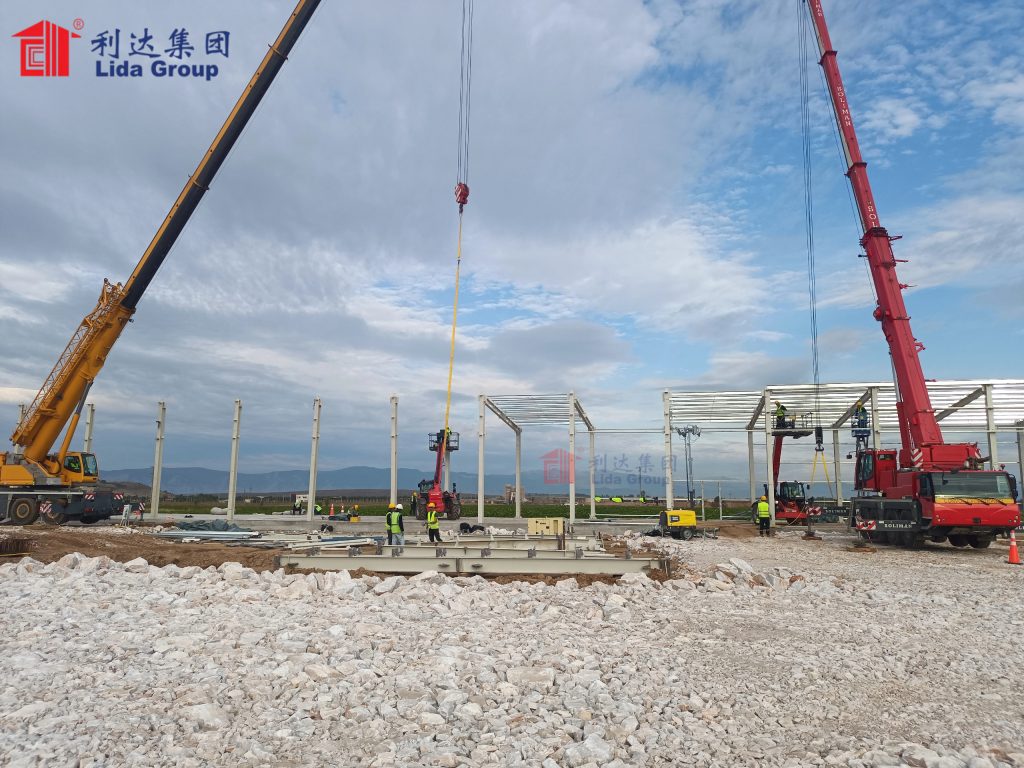
2. The Critical Needs of Global Logistics Firms in Warehouse Infrastructure
Before examining Lida Group’s solutions, it is essential to understand the specific needs that drive global logistics firms’ warehouse decisions. These companies operate on a massive scale, handling millions of tons of cargo annually, and their warehouses must support a range of activities beyond basic storage, including sorting, packing, cross-docking, and integration with transportation networks (trucks, ships, and railways). As such, their warehouse requirements can be grouped into several key categories:
2.1 Strength and Durability for Heavy-Duty Operations
Global logistics warehouses are subjected to extreme stress on a daily basis. They must support the weight of:
- Heavy inventory: Pallets of goods, often stacked several meters high, can exert significant pressure on floors and structural components. For example, a warehouse storing automotive parts may have pallets weighing 1,000 kg each, stacked 5 layers high—creating a load of 5,000 kg per square meter.
- Material handling equipment: Forklifts, pallet jacks, conveyor belts, and automated guided vehicles (AGVs) are essential tools in logistics operations, but they add additional weight and wear to warehouse floors and frames. Forklifts, for instance, can weigh up to 10,000 kg and require floors that can withstand constant impact and vibration.
- Environmental stressors: Logistics warehouses are often located in regions prone to extreme weather—such as hurricanes in the Caribbean, heavy snowfall in Northern Europe, or high humidity in Southeast Asia. A durable warehouse must resist corrosion, water damage, structural fatigue, and even seismic activity to protect inventory and ensure uninterrupted operations.
2.2 Flexibility and Customizability for Evolving Operations
Logistics operations are rarely static. Firms must adapt to:
- Changing inventory types: A warehouse that stores clothing one year may need to switch to electronics the next, requiring different storage systems (e.g., shelving vs. racking) and space configurations.
- Automation integration: As logistics firms adopt technologies like robotics, AI-powered sorting systems, and IoT (Internet of Things) sensors, warehouses must be able to accommodate new equipment without major renovations.
- Fluctuating volume: Peak seasons (e.g., holiday shopping periods) can double or triple shipment volumes, requiring warehouses to expand storage space temporarily or reconfigure workflows to handle increased throughput.
2.3 Efficiency and Cost-Effectiveness
In a highly competitive industry, logistics firms are under constant pressure to reduce costs while improving efficiency. Warehouses play a key role in this by:
- Minimizing downtime: A warehouse that requires frequent repairs or is prone to structural issues can disrupt operations, leading to delayed shipments and lost revenue.
- Reducing construction time: Fast-track construction allows logistics firms to start using the warehouse sooner, generating revenue faster and meeting tight market deadlines.
- Lowering long-term costs: Durable warehouses with low maintenance requirements reduce lifecycle costs, while flexible designs eliminate the need for expensive rebuilds when operations change.
2.4 Compliance and Safety
Global logistics firms must adhere to strict regulatory standards for warehouse safety, including fire resistance, load-bearing capacity, and worker safety. Additionally, warehouses storing hazardous materials (e.g., chemicals, pharmaceuticals) need specialized designs to meet industry-specific compliance requirements. Safety is also a priority for protecting workers and preventing accidents involving heavy equipment or stored goods.
Traditional warehouse designs struggle to meet all these needs simultaneously. Concrete warehouses are strong but inflexible and time-consuming to build. Wooden warehouses are relatively quick to construct but lack durability and load-bearing capacity. Steel warehouses, however, offer a balance of strength and flexibility—and Lida Group’s designs take these advantages to the next level.
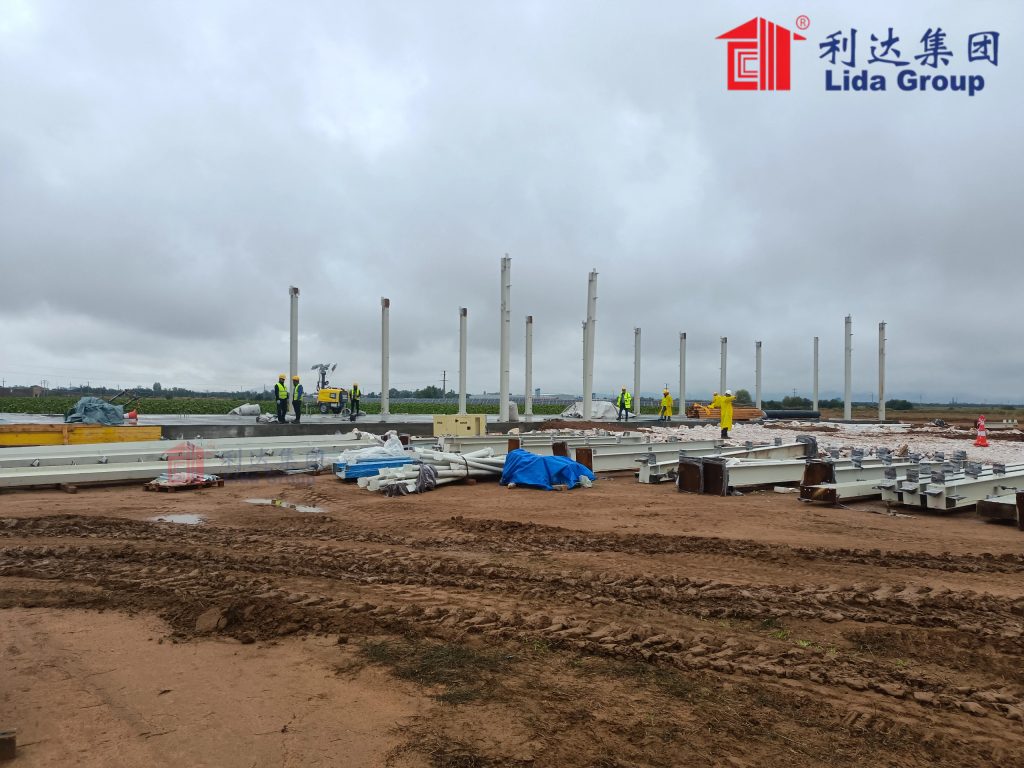
3. Lida Group’s Steel Warehouses: Unmatched Strength for Logistics Operations
Lida Group’s high-quality steel warehouses are engineered to deliver exceptional strength, making them ideal for the heavy-duty demands of global logistics. The company’s approach to strength begins with material selection and extends to structural design, manufacturing, and quality control—ensuring that every warehouse can withstand the most challenging conditions.
3.1 Premium Steel Materials: The Foundation of Strength
Lida Group sources only the highest-grade steel from reputable global suppliers, focusing on materials that offer superior load-bearing capacity, corrosion resistance, and toughness. Two key steel grades used in the company’s warehouse designs are:
3.1.1 S355JR Structural Steel
S355JR is a high-strength structural steel with a minimum yield strength of 355 MPa (megapascals)—significantly higher than the 235 MPa yield strength of standard mild steel. This makes it ideal for supporting heavy loads, such as stacked pallets and material handling equipment. S355JR also exhibits excellent ductility, which allows it to absorb energy during impacts (e.g., from a forklift collision) without cracking or collapsing. Additionally, S355JR is highly weldable, enabling seamless integration of structural components and ensuring consistent strength across the entire warehouse.
3.1.2 Hot-Dip Galvanized Steel for Corrosion Resistance
For logistics warehouses located in coastal areas, humid regions, or environments with high levels of dust or chemicals (e.g., near industrial zones), corrosion is a major threat. Lida Group addresses this by using hot-dip galvanized steel for critical components, such as columns, beams, and roof trusses. Hot-dip galvanizing involves submerging steel components in a bath of molten zinc, which forms a thick, adherent coating that acts as a barrier against moisture, oxygen, and corrosive substances. This coating can withstand up to 50 years of exposure in rural environments and 20–30 years in coastal or industrial areas—far longer than traditional paint coatings, which typically require reapplication every 5–10 years.
3.1.3 Additional Coating Options for Extreme Conditions
In particularly harsh environments, Lida Group offers optional polyester powder coating for steel components. This coating is applied electrostatically and cured at high temperatures, creating a hard, durable finish that is resistant to fading, chipping, and chemical damage. Polyester powder coating is ideal for warehouses storing chemicals or food products, as it is non-toxic and easy to clean, meeting food safety and environmental standards.
3.2 Structural Design: Engineered for Maximum Load-Bearing Capacity
Even the highest-quality steel will underperform if not supported by a well-designed structure. Lida Group’s engineers use advanced computer-aided design (CAD) and finite element analysis (FEA) software to create warehouse structures that optimize load distribution and minimize stress concentrations. Key structural features include:
3.2.1 Rigid Frame Design
Lida Group’s steel warehouses use a rigid frame design, where beams and columns are connected with rigid joints that transfer loads (e.g., weight of inventory, wind, snow) evenly across the structure. Unlike traditional pin-jointed frames, which allow for rotation at joints and can lead to structural instability under heavy loads, rigid frames create a single, integrated structure that is far more resistant to bending and deformation. This design enables Lida Group’s warehouses to span large distances (up to 40 meters) without the need for intermediate columns, creating open, unobstructed spaces that are ideal for material handling equipment and high-density storage.
3.2.2 Reinforced Roof and Floor Systems
The roof and floor of a logistics warehouse are subjected to some of the highest loads, so Lida Group engineers these components with extra reinforcement:
- Roof trusses: Roof trusses are designed using a triangular configuration, which provides exceptional strength-to-weight ratio. Lida Group’s trusses can support snow loads of up to 1.5 kN/m² (equivalent to 15 cm of wet snow) and wind loads of up to 1.2 kN/m²—critical for warehouses in regions with extreme weather. Additionally, the trusses are spaced to accommodate roof-mounted equipment, such as solar panels or HVAC systems, without compromising structural integrity.
- Floors: Warehouse floors are made from high-strength steel decking topped with a concrete slab (typically 150–200 mm thick). The steel decking provides additional support, while the concrete slab offers a durable, smooth surface that can withstand the impact of forklifts and heavy pallets. Lida Group’s floors are designed to handle live loads of up to 5 kN/m²—more than enough for most logistics applications, including heavy-duty pallet racking systems.
3.2.3 Seismic and Wind Resistance
For warehouses located in seismic zones (e.g., Japan, California) or hurricane-prone regions (e.g., Florida, Southeast Asia), Lida Group incorporates specialized design features to enhance resilience:
- Seismic bracing: Diagonal steel braces are added to the frame to absorb and dissipate energy during an earthquake, reducing the risk of structural collapse.
- Wind-resistant walls: Exterior walls are reinforced with steel panels that can withstand wind speeds of up to 150 km/h (93 mph). The walls are also designed to prevent air infiltration, which can cause damage to inventory (e.g., moisture damage to electronics) and increase heating/cooling costs.
3.3 Quality Control: Ensuring Strength and Durability
Lida Group’s commitment to strength extends to its rigorous quality control processes, which ensure that every warehouse meets or exceeds international standards. Key quality control measures include:
- Material testing: All steel materials undergo mechanical property testing (e.g., tensile strength, impact resistance) and chemical composition analysis to verify compliance with industry standards (e.g., EN 10025 for structural steel).
- Component inspection: After manufacturing, each steel component is inspected for dimensional accuracy, surface defects (e.g., cracks, bends), and coating quality. Components that fail inspection are rejected or reworked.
- On-site testing: During construction, Lida Group’s engineers conduct load tests to verify that the structure can support the designed loads. For example, floor load tests involve placing weighted pallets on the floor and measuring deflection to ensure it stays within safe limits.
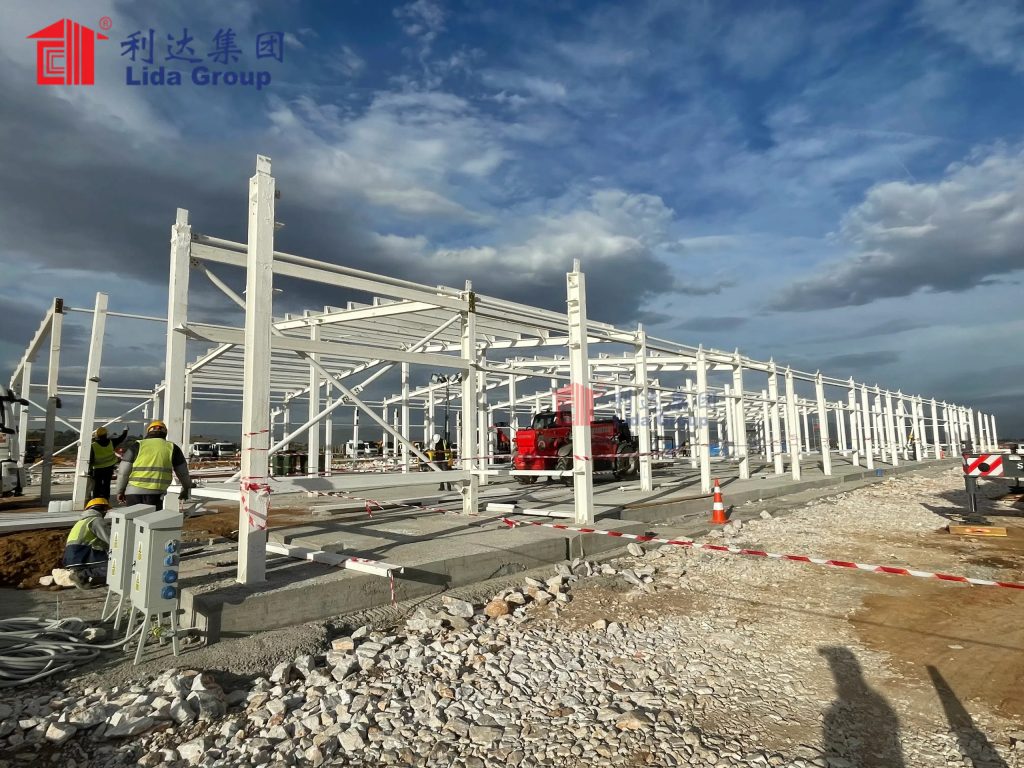
4. Lida Group’s Steel Warehouses: Tailored Customizability for Logistics Needs
While strength is essential, customizability is what sets Lida Group’s steel warehouses apart for global logistics firms. The company’s modular design approach and flexible engineering allow it to create warehouses that are tailored to the unique operational requirements of each client—whether they need a small, specialized facility for pharmaceutical storage or a large, multi-purpose warehouse for cross-docking operations.
4.1 Modular Design: Building Blocks for Flexible Spaces
Lida Group’s steel warehouses are constructed using prefabricated modular components, which are manufactured in a controlled factory environment and then assembled on-site. This modular approach offers several key advantages for customizability:
4.1.1 Scalable Sizes
Logistics firms have varying space requirements, and Lida Group’s modular design allows for easy scaling. Warehouses can be designed in any size, from 500 square meters (for small regional facilities) to 50,000 square meters or more (for large distribution centers). Additionally, modules can be added or removed as operations grow or shrink—for example, a logistics firm experiencing seasonal volume spikes can add temporary modules during peak periods and remove them afterward, avoiding the cost of building a permanently larger warehouse.
4.1.2 Customizable Floor Plans
Lida Group’s engineers work closely with clients to design floor plans that align with their specific workflows. Key customization options include:
- Storage zones: Dedicated areas for pallet racking, shelving, bulk storage, or cold storage (for temperature-sensitive goods like food or pharmaceuticals).
- Processing areas: Spaces for sorting, packing, labeling, or cross-docking, with pre-installed utility connections (electrical, water, compressed air) for equipment like conveyor belts or packaging machines.
- Office and auxiliary spaces: Integrated offices, break rooms, and maintenance areas, which can be located either within the warehouse or as attached modules. These spaces are designed to be comfortable and functional, with insulation, heating/cooling, and natural lighting.
4.1.3 Adaptable Height
The height of a warehouse is a critical factor for maximizing storage capacity. Lida Group’s steel frames can be designed to accommodate clear heights (the distance from the floor to the bottom of the roof trusses) of up to 12 meters—far higher than the 6–8 meters typical of concrete warehouses. This extra height allows logistics firms to install mezzanine floors (doubling storage space) or high-rise pallet racking systems, increasing storage density and reducing the need for additional warehouse space.
4.2 Integration of Logistics-Specific Technologies
Modern logistics operations rely heavily on technology, and Lida Group’s warehouses are designed to integrate seamlessly with the latest equipment and systems. Key technology integration features include:
4.2.1 Pre-Installed Utility Channels
Lida Group’s steel frames include pre-installed utility channels—hollow spaces within beams and columns that house electrical wiring, data cables, water pipes, and ventilation ducts. This eliminates the need for unsightly and potentially damaging surface-mounted wiring, making it easy to install and upgrade technologies like:
- Automated guided vehicles (AGVs): AGVs require power and data connections to navigate, and the utility channels allow for hidden wiring that doesn’t interfere with vehicle movement.
- IoT sensors: Sensors for inventory tracking, temperature monitoring, and equipment maintenance can be easily installed using the utility channels, providing real-time data to logistics management systems.
- Lighting and HVAC: Energy-efficient LED lighting and HVAC systems can be integrated into the utility channels, reducing energy costs and improving indoor air quality for workers.
4.2.2 Compatibility with Automation Systems
Lida Group’s warehouses are designed to accommodate a range of automation technologies, including:
- Robotic sorting systems: The open floor plans and high ceilings allow for the installation of overhead robotic sorting systems, which can process thousands of packages per hour.
- Automated storage and retrieval systems (AS/RS): AS/RS systems use robots to store and retrieve pallets, and Lida Group’s floor and ceiling designs can support the weight of these systems (up to 10,000 kg per robot) and the vertical movement of pallets.
- Conveyor belts: Conveyor belts can be integrated into the floor plan, with supports built into the steel frame to ensure stability and minimize vibration.
4.2.3 Cold Storage and Hazardous Materials Storage
For logistics firms handling temperature-sensitive or hazardous goods, Lida Group offers specialized customizations:
- Cold storage: Warehouses can be equipped with insulated walls, floors, and roofs, as well as refrigeration systems that maintain temperatures ranging from -30°C (for frozen goods) to 10°C (for refrigerated goods). The steel frame’s durability ensures that the structure can support the weight of refrigeration units and insulated panels, while the utility channels allow for the installation of temperature sensors and backup power systems.
- Hazardous materials storage: Warehouses storing chemicals, flammable goods, or pharmaceuticals can be designed with fire-resistant walls, explosion-proof electrical systems, and specialized ventilation to meet regulatory requirements. Lida Group’s steel frames are non-combustible, reducing the risk of fire spread, and the modular design allows for segregated storage zones to prevent cross-contamination.
4.3 Fast Construction: Customization Without Delays
One of the biggest advantages of Lida Group’s modular design is its speed of construction. Traditional concrete warehouses can take 12–16 weeks to build, but Lida Group’s steel warehouses can be constructed in 4–8 weeks—depending on size—thanks to prefabrication. Here’s how the process works:
- Design phase: Engineers work with the client to finalize the warehouse design, including size, floor plan, and custom features. This phase typically takes 2–3 weeks.
- Manufacturing phase: Steel components are manufactured in Lida Group’s factory using CNC (Computer Numerical Control) machines, which ensure precision and consistency. This phase takes 3–4 weeks.
- On-site assembly: Prefabricated components are transported to the site and assembled by Lida Group’s construction team. Since the components are pre-cut and pre-drilled, assembly is fast and requires minimal on-site modification. This phase takes 1–2 weeks for small warehouses and 4–5 weeks for large facilities.
The fast construction timeline allows logistics firms to start using the warehouse sooner, reducing time-to-revenue and enabling them to respond quickly to market opportunities (e.g., a new client contract or a seasonal demand spike).
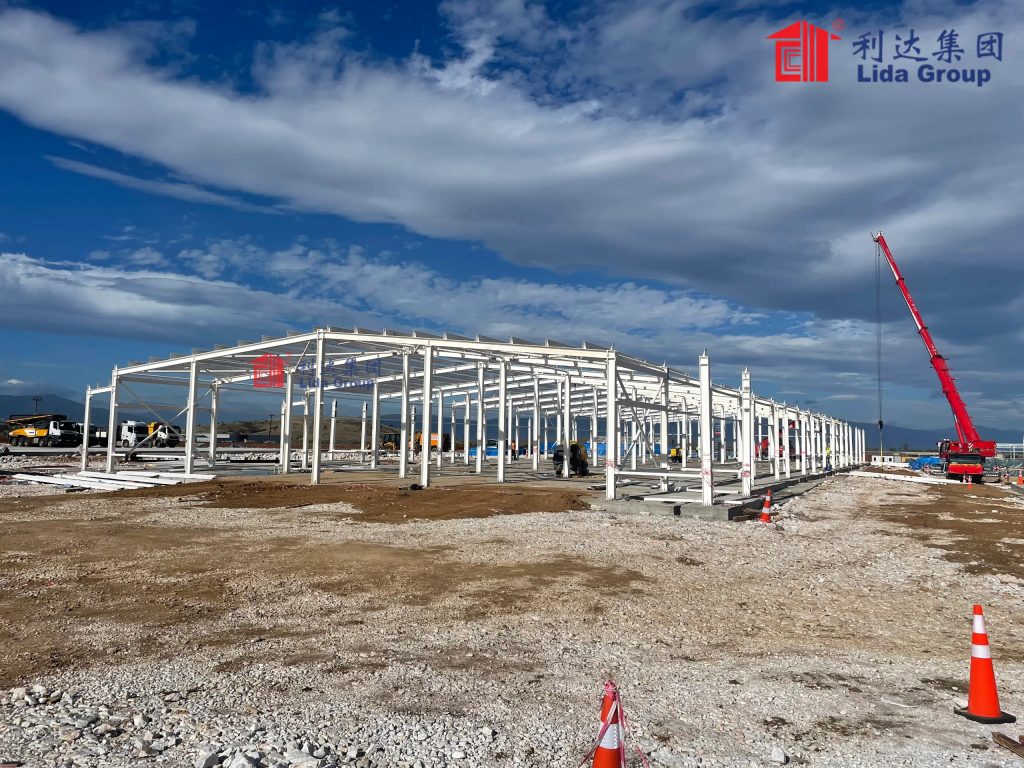
5. Case Studies: Global Logistics Firms Benefiting from Lida Group’s Steel Warehouses
To illustrate the real-world impact of Lida Group’s steel warehouses, this section examines three case studies of global logistics firms that have adopted these solutions. Each case study highlights how the warehouse’s strength and customizability addressed specific operational challenges and delivered measurable benefits.
5.1 Case Study 1: E-Commerce Logistics Firm in Southeast Asia
A leading e-commerce logistics firm with operations across Southeast Asia needed a 15,000-square-meter warehouse in Singapore to handle the region’s growing e-commerce demand. The firm’s key requirements were:
- Strength to support heavy pallet racking: The warehouse needed to store up to 10,000 pallets of electronics and consumer goods, with each pallet weighing 800 kg.
- Flexibility to handle seasonal volume: During peak shopping periods (e.g., Singles’ Day, Christmas), the firm expected shipment volumes to double, requiring additional storage space and processing capacity.
- Resistance to high humidity: Singapore’s tropical climate (average humidity of 80%) posed a risk of corrosion and moisture damage to inventory.
Lida Group’s solution was a modular steel warehouse with the following features:
- Structural strength: The warehouse used S355JR steel frames with a rigid design, capable of supporting floor loads of 5 kN/m²—more than enough for the 800 kg pallets. The roof trusses were reinforced to handle Singapore’s heavy rainfall (average annual rainfall of 2,340 mm) and strong winds.
- Customizable floor plan: The warehouse included three zones: a 10,000-square-meter pallet storage area with high-rise racking (up to 10 meters tall), a 3,000-square-meter processing area with conveyor belts and sorting robots, and a 2,000-square-meter office space. Modular walls were installed between zones, allowing the firm to reconfigure the space during peak seasons.
- Corrosion resistance: All steel components were hot-dip galvanized, and the warehouse included a dehumidification system to maintain humidity levels below 60%—protecting electronics from moisture damage.
Since the warehouse opened in 2022, the firm has reported:
- 0 structural issues: The warehouse has withstood heavy loads and tropical storms without any damage or downtime.
- 30% increase in storage capacity during peak seasons: By reconfiguring the modular walls, the firm was able to expand the storage area to 13,000 square meters during peak periods, handling double the usual shipment volume.
- 25% reduction in maintenance costs: The galvanized steel components have required no repainting or corrosion repairs, and the dehumidification system has reduced inventory damage by 40%.
5.2 Case Study 2: Pharmaceutical Logistics Firm in Europe
A global pharmaceutical logistics firm needed a 8,000-square-meter warehouse in Germany to store temperature-sensitive medications and vaccines. The firm’s requirements were:
- Temperature control: The warehouse needed to maintain a constant temperature of 2–8°C (for medications) and -20°C (for vaccines), with no fluctuations.
- Compliance with EU regulations: The warehouse had to meet strict EU standards for pharmaceutical storage, including airtightness, cleanliness, and traceability.
- Strength to support cold storage equipment: The refrigeration units and insulated panels would add significant weight to the structure.
Lida Group designed a specialized cold storage steel warehouse with:
- Insulated steel structure: The walls, roof, and floor were insulated with high-density polyurethane foam (R-value of 30), which prevents heat transfer and maintains stable temperatures. The steel frame was reinforced to support the weight of the insulation and refrigeration units (total weight of 50,000 kg).
- Custom temperature zones: The warehouse was divided into two separate zones—one for medications (2–8°C) and one for vaccines (-20°C)—each with its own refrigeration system and backup power supply. Utility channels were used to install temperature sensors and data loggers, which track and record temperatures every 15 minutes for compliance purposes.
- Airtight design: All joints and openings were sealed with airtight gaskets to prevent temperature leakage, and the warehouse included an air filtration system to maintain clean air (class 8 cleanroom standards).
Since opening in 2023, the warehouse has:
- Maintained 100% temperature compliance: The insulation and refrigeration systems have kept temperatures within the required range, even during extreme cold snaps in Germany (temperatures as low as -15°C).
- Reduced energy costs by 20%: The high-efficiency insulation and refrigeration systems use less energy than the firm’s previous concrete cold storage facility.
- Passed all EU inspections: The warehouse has successfully complied with EU regulations, allowing the firm to expand its pharmaceutical logistics operations in Europe.
5.3 Case Study 3: Automotive Logistics Firm in North America
An automotive logistics firm specializing in transporting and storing car parts needed a 20,000-square-meter warehouse in Michigan (USA) to support its operations for a major automaker. The firm’s key needs were:
- Strength to handle heavy equipment: The warehouse needed to accommodate forklifts weighing up to 12,000 kg and store large car parts (e.g., engines, chassis) weighing up to 2,000 kg each.
- Flexibility to integrate automation: The firm planned to install AGVs and robotic palletizers to improve efficiency, requiring a warehouse design that could support these systems.
- Resistance to snow and ice: Michigan’s harsh winters (average snowfall of 150 cm) required a warehouse that could withstand heavy snow loads and freezing temperatures.
Lida Group’s solution was a robust steel warehouse with:
- Heavy-duty structure: The frame used S355JR steel with reinforced floor beams and roof trusses, capable of supporting floor loads of 6 kN/m² and snow loads of 1.5 kN/m². The floor was made from 200 mm thick concrete topped with a wear-resistant coating, which can withstand the impact of heavy forklifts.
- Automation-ready design: The warehouse included pre-installed utility channels for AGV power and data connections, as well as reinforced floor areas where robotic palletizers would be installed. The high ceiling (10 meters) allowed for the installation of overhead conveyor systems to transport parts between storage and processing areas.
- Winter resilience: The roof was sloped at 30 degrees to facilitate snow runoff, and the warehouse included a snow-melting system on the roof edges to prevent ice buildup. The steel components were hot-dip galvanized to resist corrosion from road salt (used to melt snow on nearby roads).
Since the warehouse opened in 2021, the firm has experienced:
- Increased efficiency: The AGVs and robotic palletizers have reduced labor costs by 35% and increased throughput by 50%.
- No winter-related downtime: The warehouse has withstood heavy snowstorms without structural damage, and the snow-melting system has prevented ice-related accidents.
- Extended equipment lifespan: The durable floor and protected storage areas have reduced damage to forklifts and car parts, extending their lifespan by 2–3 years.
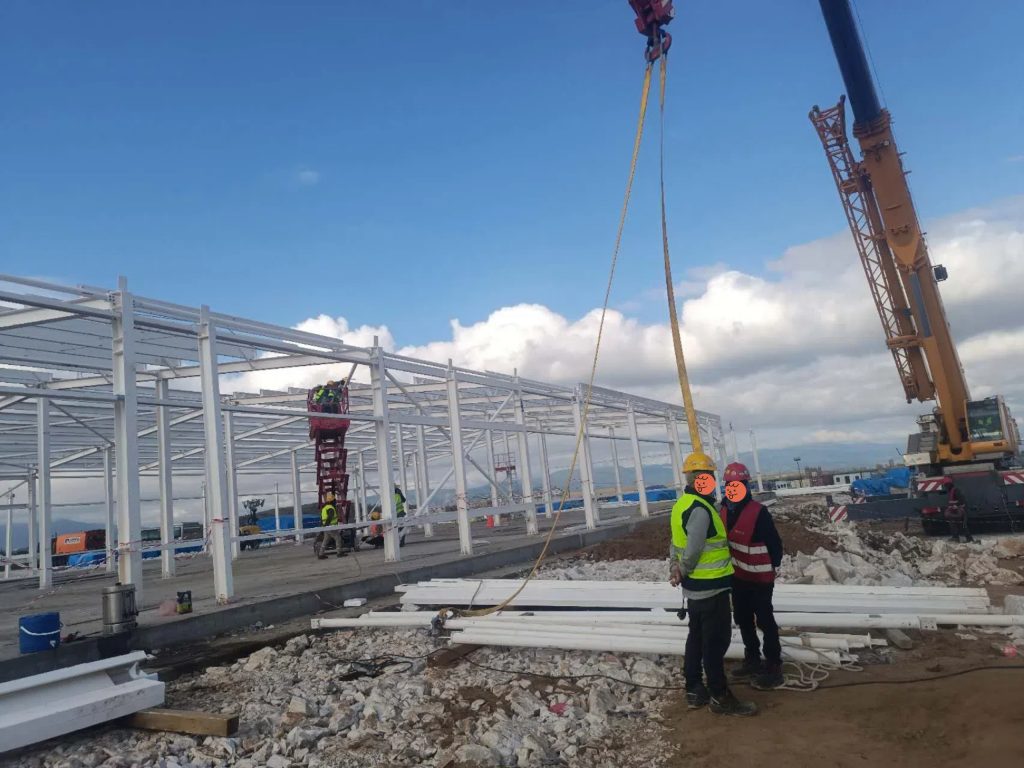
6. Industry Recognition and Certifications
Lida Group’s high-quality steel warehouses have earned widespread recognition from the logistics and construction industries, as well as certifications from leading global organizations. These accolades validate the company’s commitment to strength, customizability, and quality.
6.1 Key Certifications
- ISO 9001:2015 Quality Management System: This certification recognizes Lida Group’s ability to consistently deliver products and services that meet customer and regulatory requirements. It covers all aspects of the company’s operations, from design and manufacturing to construction and after-sales support.
- ISO 14001:2015 Environmental Management System: Lida Group’s commitment to sustainability is validated by this certification, which focuses on reducing environmental impact. The company’s use of recycled steel (up to 50% of total steel used), eco-friendly coatings, and energy-efficient designs align with ISO 14001 standards.
- CE Certification: For warehouses sold in the European Union, Lida Group’s steel structures meet the CE mark’s requirements for safety, health, and environmental protection. This includes compliance with EN 1090 (structural steelwork) and EN 13501 (fire classification).
- AWS D1.1 Structural Welding Code: This certification ensures that the welding of steel components in Lida Group’s warehouses meets the highest standards for strength and durability. It is critical for ensuring that the structure can withstand heavy loads and environmental stressors.
6.2 Industry Awards
- 2023 Global Logistics Infrastructure Award: Lida Group won this award for its e-commerce warehouse in Singapore, recognized for its innovative design that balances strength, flexibility, and efficiency.
- 2024 Sustainable Construction Award: The company’s pharmaceutical warehouse in Germany received this award for its energy-efficient cold storage design and use of eco-friendly materials.
- 2022 Steel Structure Excellence Award: Lida Group’s automotive warehouse in Michigan was honored with this award for its robust structural design and ability to support heavy equipment and automation.
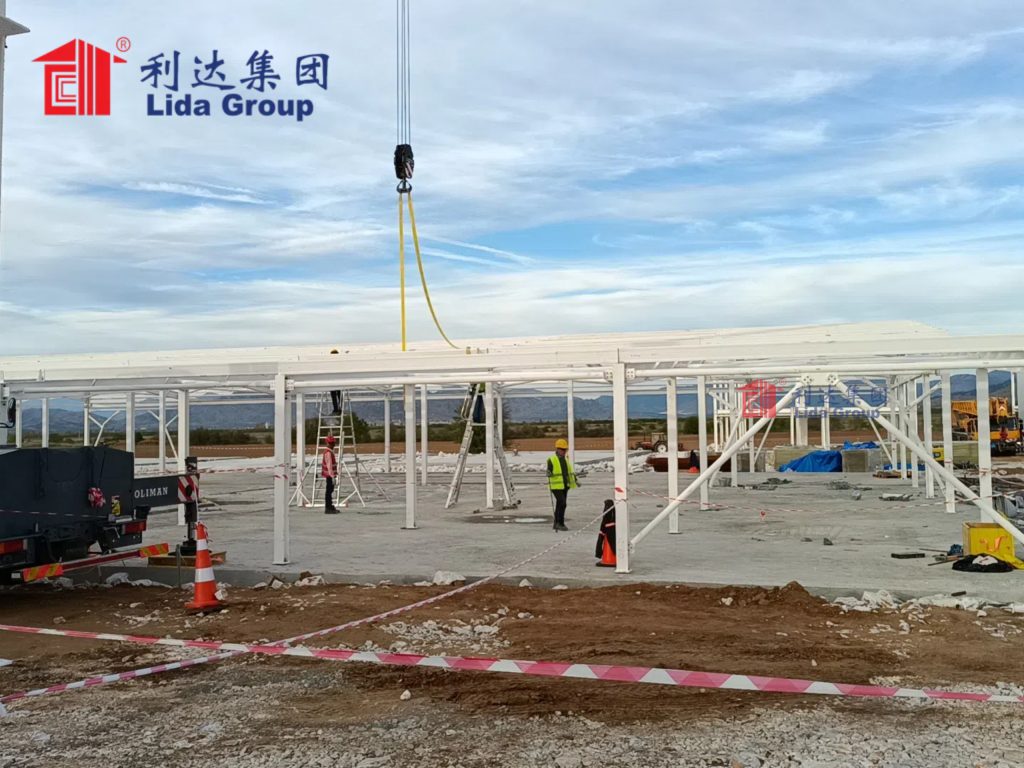
7. The Future of Logistics Warehouses: Lida Group’s Ongoing Innovations
As global logistics continues to evolve, Lida Group is committed to staying at the forefront of warehouse innovation. The company’s research and development (R&D) team is focused on three key areas to further enhance the strength and customizability of its steel warehouses:
7.1 Advanced Steel Alloys
Lida Group is collaborating with steel manufacturers to develop new high-strength, lightweight steel alloys that offer even greater load-bearing capacity and corrosion resistance. One promising alloy, currently in testing, has a yield strength of 500 MPa—30% higher than S355JR—while being 15% lighter. This alloy would allow Lida Group to design warehouses with even larger spans and higher storage densities, reducing the need for additional land and lowering construction costs.
7.2 Smart Warehouse Integration
The future of logistics is smart, and Lida Group is integrating IoT and AI technologies directly into its warehouse designs. Key innovations include:
- Smart sensors: Embedded sensors in steel components will monitor structural health (e.g., stress, corrosion) in real time, alerting maintenance teams to potential issues before they become critical.
- AI-powered energy management: Smart systems will optimize heating, cooling, and lighting based on occupancy and inventory levels, reducing energy costs by up to 30%.
- Digital twins: Lida Group is developing digital twins of its warehouses—virtual replicas that allow logistics firms to test new layouts, equipment, or workflows before implementing them in the physical warehouse. This will further enhance customizability and reduce the risk of operational disruptions.
7.3 Circular Economy Practices
Sustainability is a growing priority for logistics firms, and Lida Group is working to make its steel warehouses more circular. The company is developing modular designs that allow components to be easily disassembled and reused in new warehouses, reducing waste and minimizing the environmental impact of deconstruction. Additionally, Lida Group is partnering with recycling companies to ensure that steel components from old warehouses are recycled into new steel products, closing the loop on the material lifecycle.

8. Conclusion
In conclusion, Lida Group’s high-quality steel warehouses have become the preferred choice for global logistics firms because they deliver the two attributes that matter most in a dynamic logistics environment: exceptional strength and unmatched customizability. By using premium steel materials, engineering robust structural designs, and implementing rigorous quality control, Lida Group ensures that its warehouses can withstand the heavy loads, extreme weather, and constant equipment use that define logistics operations. At the same time, the company’s modular design approach, fast construction timeline, and ability to integrate logistics-specific technologies allow it to create warehouses that are tailored to the unique needs of each client—whether they handle e-commerce packages, pharmaceuticals, or automotive parts.
The case studies highlighted in this article demonstrate the real-world value of Lida Group’s solutions: logistics firms have experienced reduced downtime, lower maintenance costs, increased efficiency, and the ability to adapt to changing operations—all while meeting strict regulatory standards. Industry certifications and awards further validate the quality and innovation of Lida Group’s warehouses, giving logistics firms confidence in their investment.
Looking to the future, Lida Group’s ongoing innovations in advanced steel alloys, smart warehouse integration, and circular economy practices will continue to enhance the strength and customizability of its solutions. As global logistics becomes more complex and competitive, Lida Group’s steel warehouses will remain a strategic asset for firms seeking to optimize their operations, reduce costs, and stay ahead of the curve.
For global logistics firms looking to invest in warehouse infrastructure that delivers long-term value, reliability, and flexibility, Lida Group’s high-quality steel warehouses are the clear choice. These warehouses are not just structures—they are partners in success, enabling logistics firms to meet the demands of today’s global supply chain and prepare for the challenges of tomorrow.

Related news
-
Agricultural Modernization Accelerated by Lida Group's Innovative Steel Frame Building Solutions for Modern Farm Houses
2025-08-26 10:20:24
-
Lida Group Sets a New Industry Standard for Durability with Its High-Quality Steel Structure Warehouse Designs.
2025-08-26 10:06:38
-
Cost-Effective Expansion: Lida Group's Prefab Building Approach Cuts Temporary Sandwich House Construction Time and Budgets
2025-08-25 17:25:38
contact us
- Tel: +86-532-88966982
- Whatsapp: +86-13793209022
- E-mail: sales@lidajituan.com


